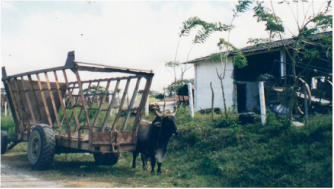
One memorable day, we drove from Havana to the Sierra del Rosario Reserva de la Biosfera – a newly protected ecological area. En route, we passed once luxurious mansions that had been owned by officials in Batista’s government, Mafia lords, and foreign businessmen. Eventually, we came to mango orchards, coffee plantations, hillsides of hibiscus, and sugar cane plantations. Although much smaller than it once was, the sugar cane industry still employed more than 300,000 people.
Passing through rich farmlands, we came to the colonial town of Remedios. At one time, Remedios boasted 72 sugar mills, but most had closed because of the reduced market for cane sugar. The town was founded in 1513 by a Spanish grandee, Vasco Porcallo de Figueroa. He turned the native people into slaves, but the riches from sugar transformed little Remedios into a showplace of elegant colonial architecture.
Another day, we visited the remains of the vast Iznaga Sugar Cane Plantation, which in the 17th and 18th centuries was virtually an independent empire. From a central tower, Spanish overseers made sure that employees and slaves were always working. For three centuries, vast plantations such as this produced sugar for the world. Because so much land was dedicated to this one crop, much of the food needed by the Cubans had to be imported.
The United States became a guaranteed market for cane sugar. Money flowed in and out of Cuba, eventually much of it through the Mafia, and Havana became a corrupt playground for rich Americans. Very little of the money reached the Cuban people. After Batista was overthrown in 1959, an effort was made to end the dependency on sugar cane, but the U.S. embargo – known as the “blockade” in Cuba – drove the country to rely on sugar exports again. This time, it was the Soviet Union and the Eastern Block who bought the sugar and sent food, fuel, and other necessities to the island. When the Soviet Union and Eastern Block collapsed in 1989, their economic support of Cuba also collapsed.
We visited a sugar cooperative in the famous Valley of Sugar Cane Mills. Because of the drastically reduced demand for cane sugar, they were trying to diversify, raising cattle, pigs, goats, bananas, vegetables, and rice. Many sugar cane fields were being changed to food production. Much rice still was being imported from China and Vietnam, but Cuba aimed to become self-sufficient.
Life remains difficult in these rural areas. Passing mile after mile of farms and sugar cane fields, we had to maneuver around antique tractors and farm machines, old trucks, carts and horse-drawn wagons, even bicycles. Many farmers used oxen for plowing. Because of the fuel shortage, animals often were used for farming.
Cuba is a potentially rich land blessed by nature, but also a country dominated by foreign powers for most of its history. When we looked beyond the bright flowers and the lively rhythms of the salsa music, it was easy see the suffering this had caused. Now, as new economic opportunities are introduced, the possibilities are almost endless.
I have to wonder, though, if all the changes will be positive. Will those meandering roads that crisscross the island’s lush countryside sprout billboards where none have ever stood? Will factories pollute the blue skies and sparkling waters? Will the Cubans and the rest of the world work together to improve life on the island for everyone, without destroying its natural beauty and vast potential? Will the heart and soul of Cuba survive the transformation now beginning?
 RSS Feed
RSS Feed